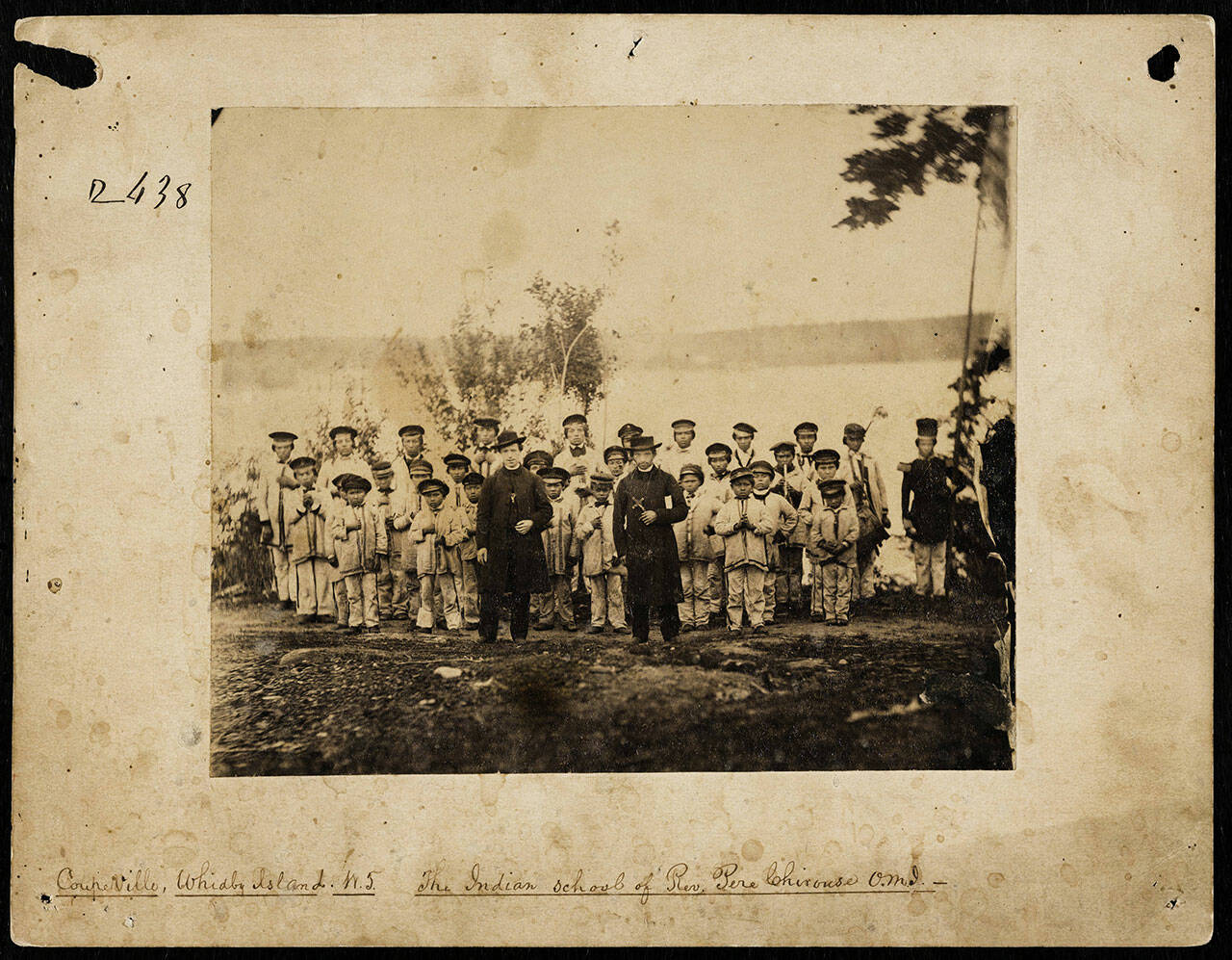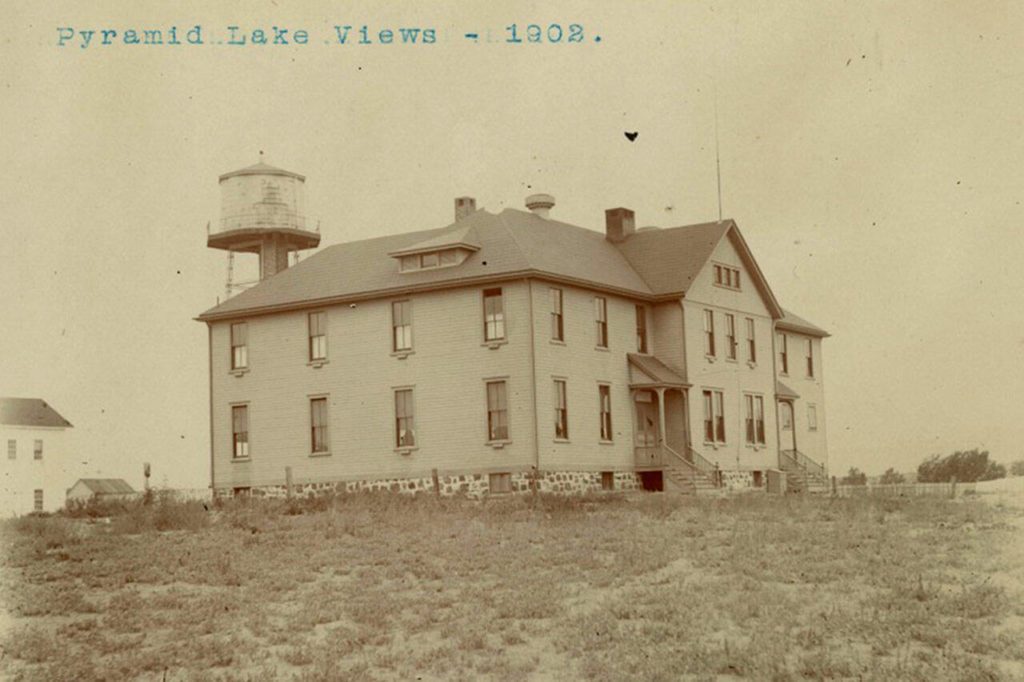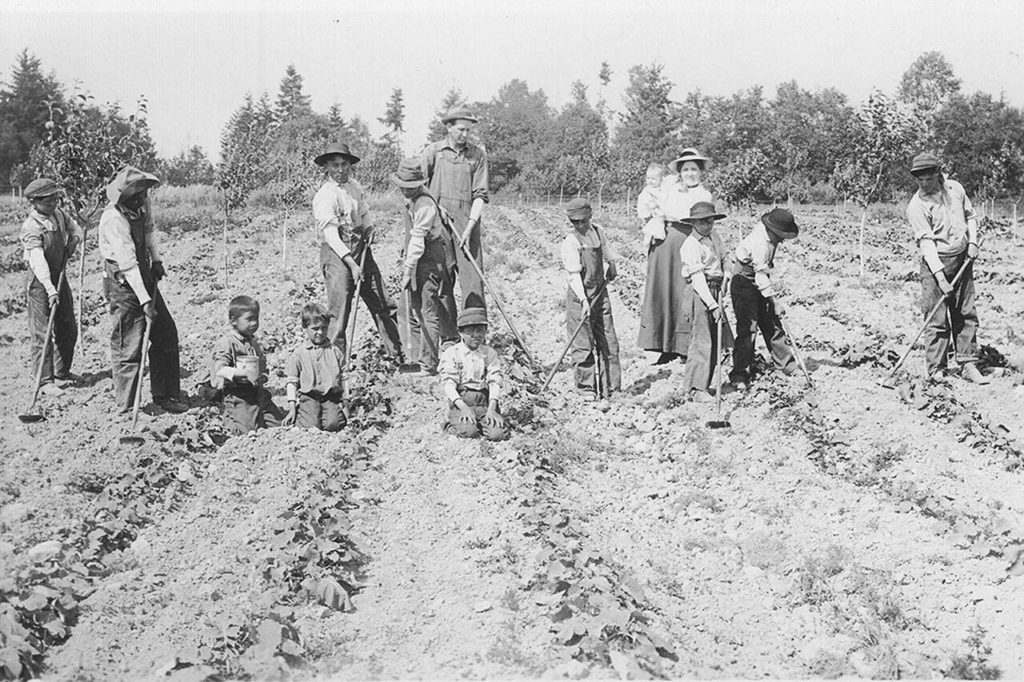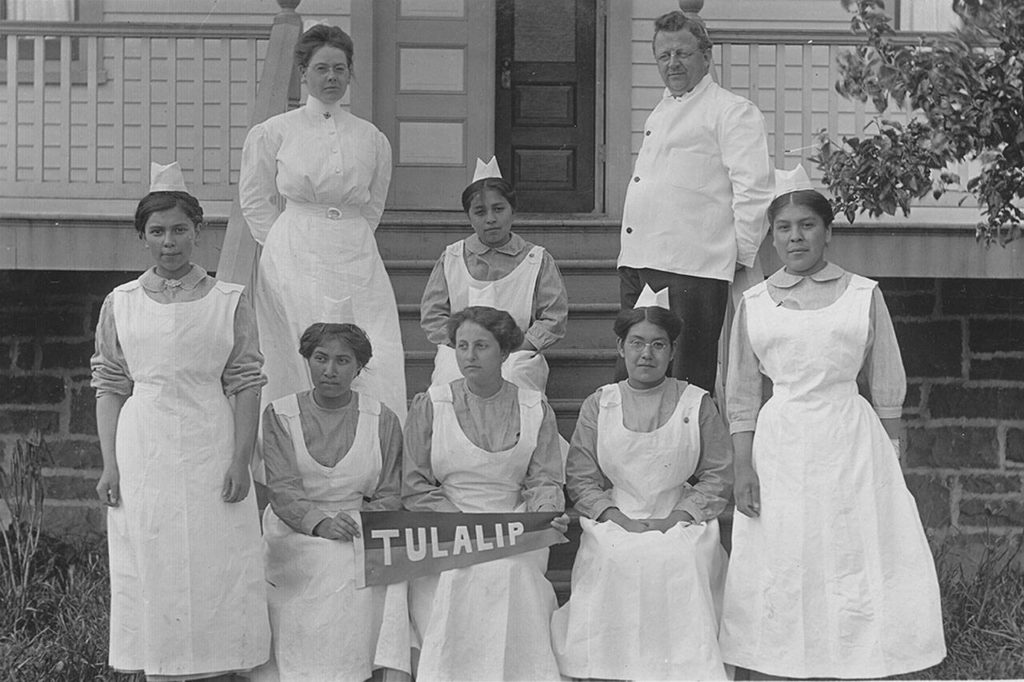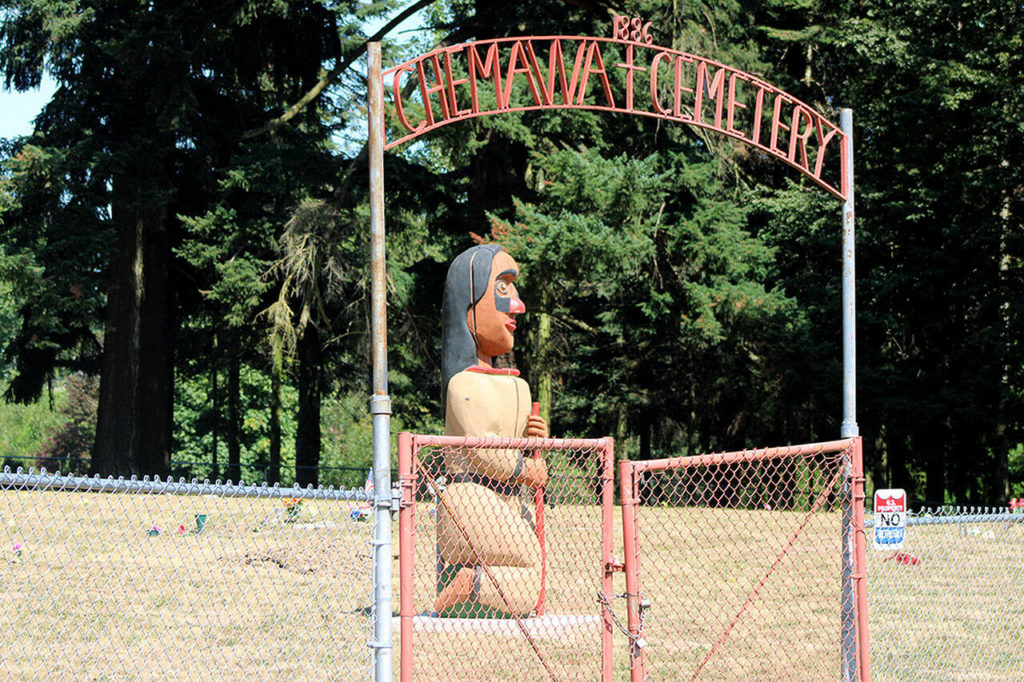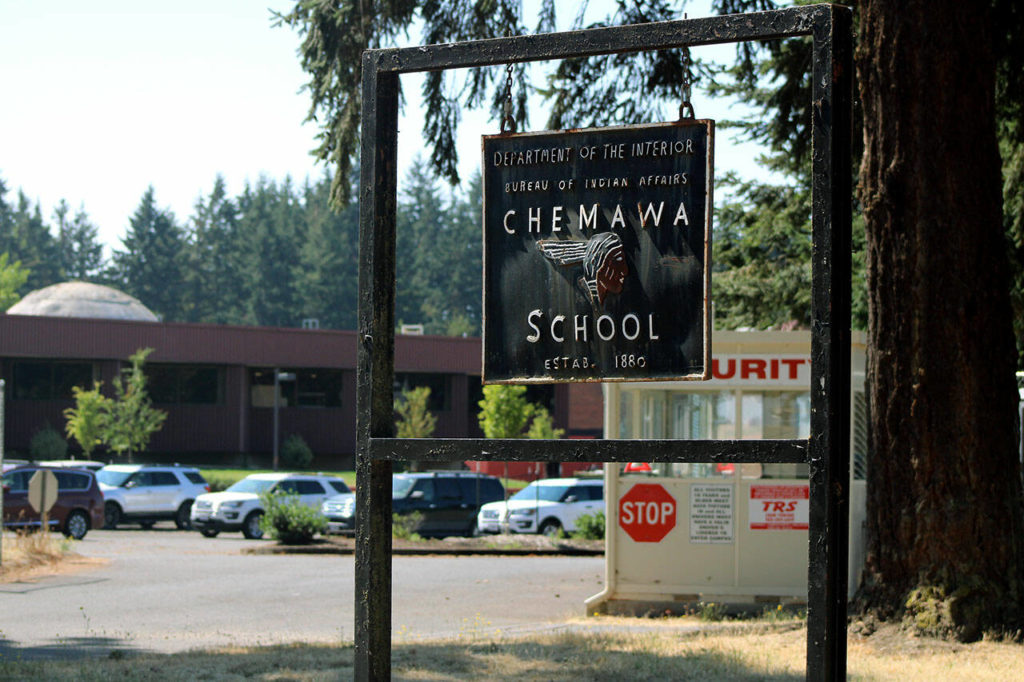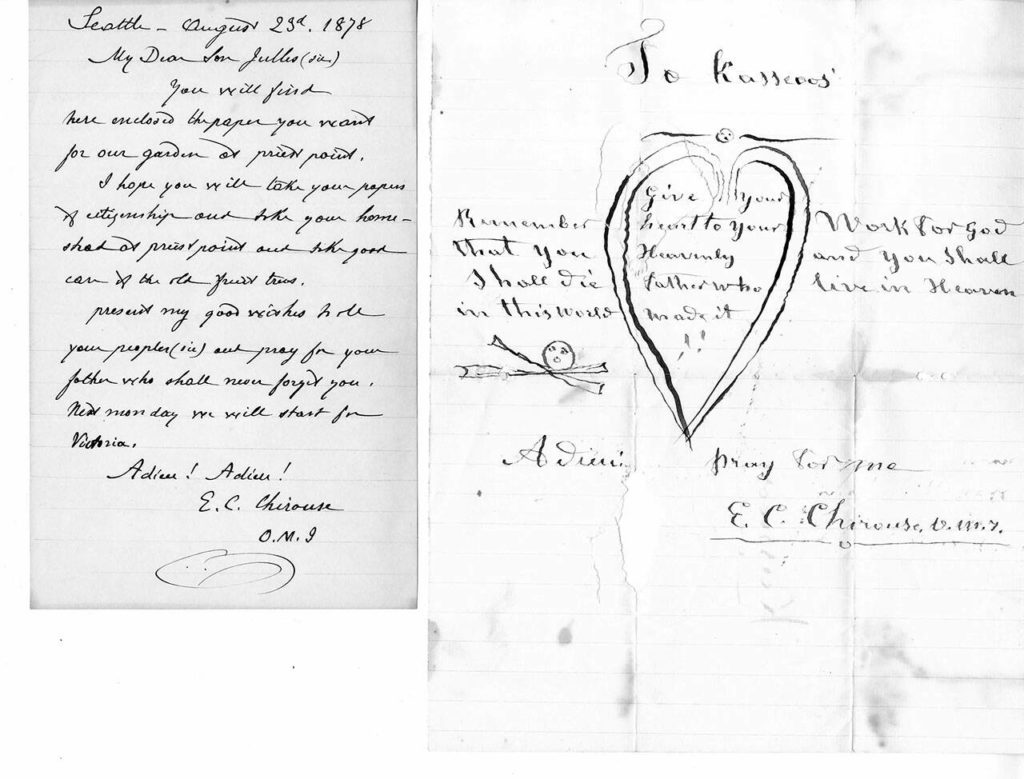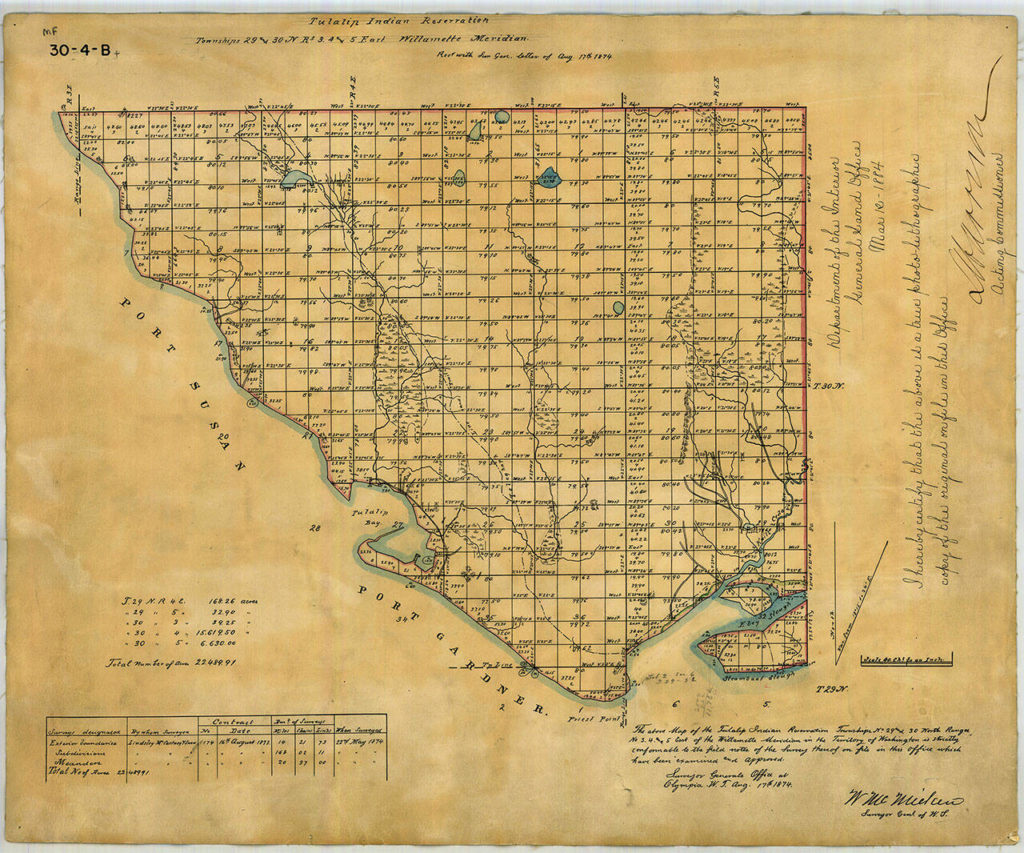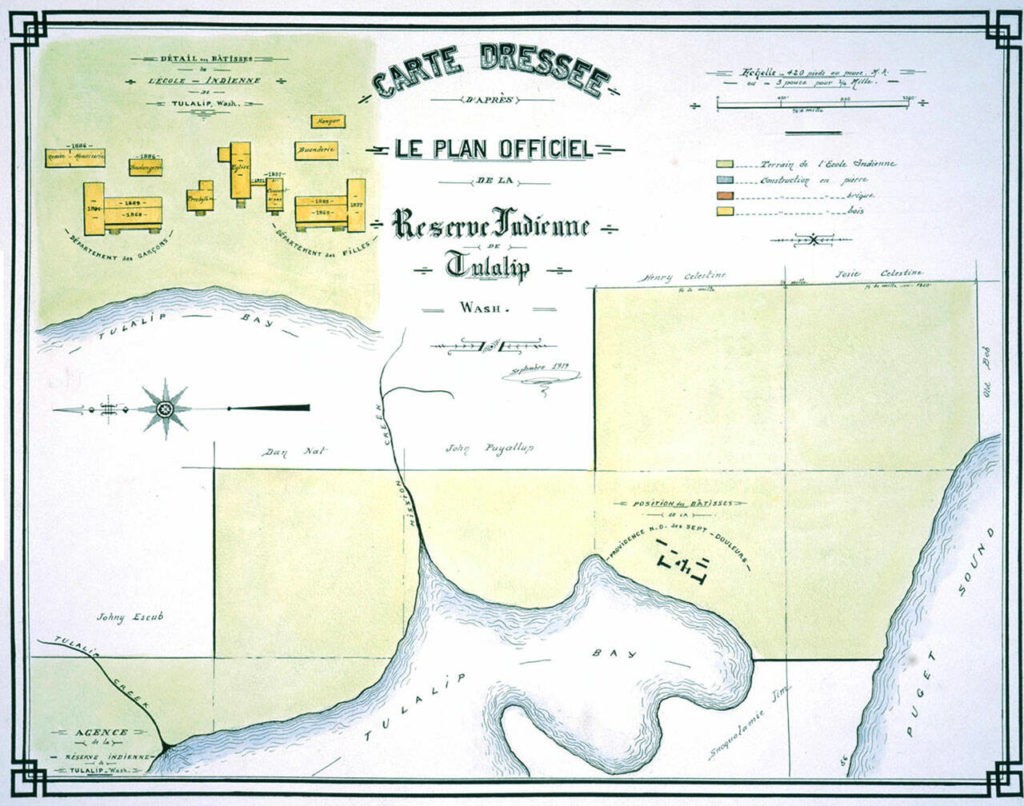Editor’s note: This is the second in a series of three stories about the history and lingering trauma of the federal Tulalip Indian School, as well as other regional boarding schools attended by Tulalip children.
TULALIP — One night at the Tulalip Indian School, someone woke Rose Fryberg and eight other children, handing them brown sacks to pack their things and ushering them out of the dormitory.
“No, I didn’t know where I was going, I really didn’t,” said the elder, fondly known around Tulalip as Grandma Rose, in an interview with historians 60 years later.
After a long train ride, they stopped at a platform deep in a desert, she recalled. There was no breeze in the basin of sand and sagebrush, and it was hot. It was another 70 miles by horse-pulled wagon from Lovelock to Nixon, Nevada. There, at the Pyramid Lake Sanatorium, Fryberg spent the next year of her life — despite not being ill. She was 11.
Fryberg became one of tens of thousands of Native children severed from their families under false pretenses, caught up in a U.S. government campaign of cultural genocide that lasted well over a century. Authorities uprooted generations from traditional ways of life. Fryberg spent her childhood shuttled between boarding schools across the West, as she recounted before she died in 1995.
At Tulalip, many children suffered indelible wounds from sexual, mental and physical abuse, according to their descendants.
In 1857, a Catholic priest started one of the first Native American boarding schools in the country here, at the mouth of the Snohomish River.
The aim was assimilation: snuffing out Indigenous spirituality, language and traditions, and injecting that of the colonizers. Native students from around the Pacific Northwest were forced to attend the school, in its various iterations, from 1857 to 1932.
In 1868, the federal government financially backed this kind of institution for the first time, signing a contract with missionaries in Tulalip for a religious institution.
In the early 1900s, federal officials inherited schools across the country, including the campus in Tulalip. Children of this period endured beatings, sexual abuse and trauma that rippled across generations. At the campaign’s peak in the 1920s, the government separated over 60,000 kids from their families, or about 83% of school-age Native Americans, according to the National Native American Boarding School Healing Coalition.
At the Tulalip boarding school, staff gave students numbered uniforms. On rare breaks when they returned to their families, children sometimes met new siblings or step-parents. They felt disconnected and forgotten.
Growing up, Fryberg had no real sense of home. She was born near Chehalis. Tulalip was foreign to her.
“I guess I cried a lot,” she said in the recorded interview. “And the nurse, or matron I guess, used to come and ask me what’s the matter, and I said I just don’t feel good. That’s all I’d say. I don’t feel good.”
Nevada was unknown to her, too. So was Salem, Oregon, where she boarded at Chemawa Indian School as a teen.
At the Tulalip school, each morning children ate slimy oatmeal, often writhing with white worms. Hungry kids fought over apple cores. Disease spread fast in overcrowded dorms. Many did not survive.
Another Tulalip girl lived with Fryberg at the sanatorium. Clarinda Williams was truly ill. Other kids played outside the hospital. Williams sat in a small room, dying.
“We couldn’t go into the room, but we always saw her through the little screen,” Fryberg said. “We always said, ‘Good morning, Clarinda,’ or ‘Hi Clarinda.’ … But she died there, there at the sanatorium.”
She was buried in Nevada for a few months, Fryberg said, until her parents demanded her body be returned to Tulalip.
‘To rid us of our evil ways’
A bell perched high atop Tulalip Bay in a white tower is all that remains of the original Catholic mission at Tulalip. Like those sparse remnants, firsthand accounts of life in the mission school have eroded with time.
The mission’s roots go back to 1857, when a pair of French priests visited 20 tribes and baptized 500 Indigenous people into the Catholic faith. It was the priests’ fourth canoe voyage around Puget Sound. According to oral tradition, at the end of the five-month trip, Rev. Eugene Casimir Chirouse asked permission from the Snohomish chief, Ns’ski-oos, to live on the land. He recruited young boys to help him clear four acres of timber and build a log schoolhouse near the banks of Quil Ceda Creek.
Chirouse found his calling at the age of 15, while living in Bourge-de-Péage in the countryside of southeast France, when he read an account of missionaries in the Wild West. He helped build missions in Olympia, Walla Walla and canyonland west of Yakima, in what was then Oregon Territory.
“Chirouse had a mind that never seemed to rest,” according to research by local historian Betty Lou Gaeng. “It was as if he were driven by a force beyond himself.”
As a “master of Salish dialects,” Chirouse translated the Bible into Native languages. He arrived in Tulalip at the age of 36. For the next two decades, he served as schoolmaster.
Six boys and five girls became his first students. After about a year of living by the marshes at the mouth of Quil Ceda, the priest moved to what is now known as Priest Point. He asked the U.S. government for its seal of approval to build a campus.
“The Superintendant cheerfully grants this permission and only suggests that you instruct the Indians in the English language if you possibly can,” the territory Indian agent wrote in October 1859. “He assumes, and correctly, that they must acquire the civilized language of the country before they can be civilized themselves, in other words thinks that is the first step.”
Chirouse helped plant a garden at the mission. He grew pear trees that bore fruit for over a century. He charmed the locals with songs on violin and accordion. Within his first two years at Tulalip, about 200 Indigenous people built homes to settle around him. The priest offered free meals, clothing, education — “trying to do all in my power to ameliorate the miserable condition of the poor Indians under my charge,” he wrote in one letter. He urged Natives to trade “superstitious” ways for rosaries, and to renounce vices imported by white pioneers, like gambling and alcohol.
At least 408 Native American boarding schools operated with federal funds in the United States. Catholic, Protestant and Mormon missionaries ran about one-third of the schools, according to the National Native American Boarding School Healing Coalition.
“They all made deals with the government to take my people and to put the church on the reservation,” said Terry Fast Horse, 52, a son of boarding school survivors and a Tulalip resident. “And then to, basically, condition us. To rid us of our ‘evil ways.’”
The federal government framed mission schools for Native youth as a form of charity. As early as 1819, the Civilization Fund Act tasked people of “good moral character” to teach Native children to read, write and do math, with the “purpose of providing against the further decline and final extinction of the Indian tribes.”
Educators stripped Native people of their language, religion and traditions. School officials chopped students’ hair, an act that carries cultural weight for some tribes.
“Twenty-six pupils have been received into the school during the year, all as boarding scholars,” Chirouse wrote in 1862. “Of this number, four have been taken away by their parents, one of the best was removed by death, and one ran away; consequently twenty are now in attendance.”
The priest aimed to convert boys and girls into not only Christians, but “good farmers” who could grow their own crops, too, “which is said to be in accordance with the expressed wish of the (War) department,” he wrote to the federal government.
Children as young as 7 became workers.
“The boys have planted about ten acres of potatoes, peas, and other vegetables, but owing to the great drought they are not likely to be rewarded for their amount of labor,” Chirouse wrote in 1869. “… They have done some very heavy work on the reservation in clearing and making roads through the forest, and also clearing a piece of ground and fencing same, now used as a public cemetery. Some of them made the remark that it was hard work to perform without remuneration.”
Chirouse planted churches all around Puget Sound, at Lummi (1868), Swinomish (1869), Port Madison (1870) and Muckleshoot (1880). Often he referred to Indigenous people as “savages” in his letters to government officials. He also extolled children who aimed to “escape the degrading and demoralizing life to which they are exposed by the wicked and designing parents.” Inky hearts adorn some pages where he offered spiritual advice to former students at Tulalip.
“By all the accounts I’ve read, and all the journals I’ve read and studied, Indians loved him,” said Les Parks, 65, a Tulalip elder whose great-great-grandfather James Percival studied under Chirouse.
The French priest oversaw a school for girls at Tulalip, too, founded by sisters Blandine Colin, Mary Hyacinth and Mary Faith of the Sisters of Charity of Providence in 1868. Enrollment soon outgrew the school.
“The children followed a regular horarium, a demanding one for ‘children of the woods’ for whom time had no meaning,” according to a Sisters of Providence history of the Tulalip mission. “They rose at five, had Mass at six, followed by breakfast eaten in silence.”
‘No remedy for it’
Death loomed over the mission school.
Diseases carried by white settlers fueled an annual epidemic of measles, pneumonia, scarlet fever and tuberculosis.
According to the Catholic sisters’ history: “Sickness and death came before the sisters had been there a fortnight. The priests brought one of their young pupils, the son of a Lummi chief, to the infirmary to be nursed by the sisters. They could not save him.”
Sometimes the infirmary was full. The sick and well slept together. The Treaty of Point Elliott guaranteed doctors and medicine, but they were not delivered as promised.
“Each time (death) came to claim a child the sisters felt uneasy, fearing the parents would withdraw their children,” wrote Sister Dorothy Lentz in her history.
A former nun, Elizabeth Schoffen, wrote a memoir touching on her five years at Tulalip. She transferred there in 1884.
“Imagine, if you can, the terrible conditions I had to contend with at this school,” she wrote.
The nun described a small school packed wall to wall with about 60 girls, ages 5 to 25. They all slept in one large dorm with their beds squeezed together.
“The accomodations for cleanliness were very poor, and the stench in that sleeping room was simply nauseating,” she wrote, “and there was no remedy for it with the existing conditions, in the morning, I had to dress about twenty-five of these girls, and care for the running, mattering sores of many, who were diseased.”
Under orders from the church, Chirouse left Tulalip in 1878, taking a post on the Fraser River in British Columbia. In letters, he offered his prayers to the people of “Priest Point, Tulalip, (Quil Ceda) and (Spee-Bi-Dah) … because I love them like my own people.”
Chirouse died in 1892. Prominent places on the Tulalip Reservation still bear the names Mission Beach and Priest Point. A fire destroyed the original mission in 1902.
School officials ordered students at Tulalip to attend mass and catechism classes into the 1900s, years after the government phased out financial support for religious schools. Across the United States, nearly 20% of Native Americans are estimated to be Catholic, due in large part to boarding schools.
Seattle Archbishop Paul Etienne signed a letter in July 2021, apologizing for times when the Catholic Church’s relationship with Native Americans had been “potentially harmful.” A spokesperson for the Seattle Archdiocese told The Daily Herald the church’s archives don’t include any census or educational records from the mission school at Tulalip. The apology came amid an international reckoning with the schools’ legacy, following the discovery of mass children’s graves at Canadian boarding schools.
Until the Catholic priests arrived at Tulalip, a common Coast Salish practice was to wrap bodies of the dead in cedar blankets between a pair of cedar trees, recalled Henry Gobin, or Kwi tlum kadim, a Tulalip elder interviewed by The Herald in 2005.
Father Chirouse changed that custom and encouraged burials at Tulalip.
According to the Catholic sisters’ history: “They now had a cemetery that the Indians reverently cared for.”
‘The kindest and most careful attention’
A girl’s name and date of death are etched into a teal nameplate on a concrete slab at Chemawa Cemetery in Salem, Oregon. Moss wraps around the edges of the concrete, threatening to grow over her name, Viola Jones.
“I can assure you that we all sympathize with you in the loss of Viola, your little daughter, and understand how badly you feel about it in not being able to be here with her during her last days,” Chemawa Indian School Superintendent Edwin L. Chalcraft wrote to a Tulalip mother in January 1905. “It was as sad a task for me to wire you the news of your little daughter’s death as it was for you to receive it.”
The reported cause of death was measles. She was 9, according to a database compiled by scholars at Pacific University.
“Her funeral took place Tuesday afternoon, and you can rest assured that your little girl was given a Christian burial,” Chalcraft wrote. “You may rest assured that your girls will always have the kindest and most careful attention.”
Hundreds of identical slabs lie in perfect rows beside the Tulalip girl’s headstone. The cemetery borders Indian School Road, behind a patchy wall of trees and billboards leased by the school. It’s next to the former campus and a Christmas tree farm. A wire fence encircles the lawn, dotted with signs: “U.S. Property No Trespassing.”
On a late August morning, the cemetery sat deserted. Dry grass crinkled underfoot. Crickets chirped. Droplets of weed killer made a smacking sound against the earth as a woman sprayed the lawn. The cemetery is only a quarter-acre, but feels vast.
Marsha Small, a Montana State University doctoral candidate, has documented 222 children buried at the Chemawa Indian School, according to The Oregonian newspaper. There’s only a name and a year of death on each slab, no mention of birthdates or hometowns. Often they came from hundreds of miles away. Viola is buried between Umatilla and Shoshone children. Among the other students in the Oregon cemetery are those identified as Blackfeet, Cree, Hupa, Sioux, Win River and at least 14 simply listed as “Eskimo.”
They “never got to go home,” said Teri Gobin, 64, chairwoman of the Tulalip Tribes. “Those poor babies.”
The Tulalip Indian School only offered courses through eighth grade.
The government sent some students to faraway places to finish their education: Tacoma, Idaho, or even Kansas. Many Coast Salish teens were sent to Chemawa to finish their education. Rose Fryberg was among them. Around the time the Tulalip school closed in 1932, she was sent to Chemawa, where she lived with kids from all around the country.
Chemawa originally opened as the Forest Grove Indian Training School in 1880. Puyallup children — forced across state lines in the name of assimilation — built the original campus just down the road from Pacific University. A fire destroyed the girls’ dorm in 1884. So with new federal funding and donated land, Chemawa moved about 47 miles south to Salem.
Newspaper accounts collected by Charles Larsen, a Chemawa student and later a school employee, preserve snapshots of abuse in the school. Clippings included accusations that Chalcraft, the superintendent from 1894 to 1895 and 1904 to 1911, whipped female students. Journalists reported he also forced students to whip each other.
“I doubt if at any Indian school in the United States there is a case of immorality that does not become common knowledge of the employes (sic) and also the pupils. It is no exception at the Salem school,” Chalcraft said in an undated newspaper clipping in Larsen’s scrapbook. “Mr. Chalcraft does not deny whipping the girls, nor does he deny the general charges made.”
Another clipping says the superintendent was aware that a school employee, “Mr. Campbell,” whipped female students.
“Mr. Campbell does not deny this accusation but says that the girl whipped at that time was three quarters negro and one quarter Indian, that it is a (bad) combination and that the girl attacked the matron on the occasion for which she was punished and seriously injured her.”
Chalcraft was “temporarily relieved,” but after an investigation into the alleged abuse, a headline read: “Chalcraft Backed By Salem People.” The article said the Salem Board of Trade unanimously supported his reinstatement, and that his record should be cleared of any misconduct charges.
One of his successors, I. S. Loos, toured Alaska by boat offering “Indian youths” a chance to come to the Oregon school, free of charge, according to a clip from the Pueblo Chieftain newspaper in 1919.
By the following year, Chemawa enrolled over 900 students from 90 tribes. Nearly a third came from Alaska.
Authorities took William Campbell from Haines, Alaska to Chemawa in 1904, said his son John Campbell, 75, a Tulalip elder. William’s mother wrote to him, and he wrote to her, but school officials confiscated the letters.
“So when he went back to visit, they were bitter angry at each other for not writing,” John Campbell said. “He left on non-speaking terms.”
The son didn’t find out the truth until years later.
Instead of being able to rely on neatly kept documents, scholars have had to piece together stories behind old photographs or track down elders. Relatives of boarding school students have led efforts to uncover what really happened, like Denise Lajimodiere, whose father attended Chemawa in the 1920s. She characterized her research as “tedious” and “frustrating,” in an Oregon Public Broadcasting story published in April.
“Twenty-three students died while my father was there — the four years that my father was there,” Lajimodiere told OPB. “… That’s horrifying. I wondered, ‘Did he know them?’”
Part of the struggle, she said, is that some boarding schools across the country wouldn’t even be named as schools. They might be called an “orphanage,” a “seminary,” or like in Rose Fryberg’s case, a “sanatorium.”
Today, Chemawa is one of 15 Indian Boarding Schools still open in the country. It’s home to about 400 students from over 70 tribes. And it’s still free — for anyone enrolled in a federally recognized tribe — to study on the 86-acre compound secured by chain link fencing. The federal Bureau of Indian Education pays the travel fare.
Current school employees say the school north of Salem bears little resemblance to its sordid past.
Mark Cruz, former Indian Affairs deputy assistant secretary of policy and economic development for the U.S. Department of the Interior, said the goal of the remaining schools is to “focus on the foundations of quality grade school education” in a “culturally relevant setting.”
Just steps inside Chemawa’s dormitories, a banner shouts in bold letters: “ONE CHEMAWA.” On one of the concrete school walls, a bright orange sunset illuminates a vast Midwestern landscape painted in the outline of an arrowhead. Dozens of student murals adorn the halls, representing tribal nations as disparate as the Apache of the Southwest and the Gwich’in of the Arctic Circle.
On fences just outside the buildings, signs urge students to reach out for help if they are thinking about suicide.
Student burials stopped at the school in the 1940s. Students at Chemawa sometimes visit the cemetery and place small rocks and flowers on each headstone.
‘Kill the Indian …’
Chemawa was the second off-reservation Indian Boarding School in the country. The first was the Carlisle Indian School in Pennsylvania.
In 1875, the U.S. Army arrested over 70 Native prisoners of war from the Cheyenne, Kiowa, Apache, Comanche and Caddo tribes as part of the Red River War in the Texas Panhandle, a campaign to relocate roaming bands of Natives to reservations.
Lt. Richard Henry Pratt, their jailer at Fort Marion in Florida, required the prisoners to cut their hair, learn English and wear military gear, according to the Cumberland County Historical Society. Soldiers instructed Native men in military drill. Local women offered to teach them how to read in exchange for archery lessons. Eventually, authorities allowed them to leave the fort unchaperoned.
Pratt lobbied for funding to expand his experiment in “civilizing” Native Americans, and the federal government obliged with money to open an all-Native American school for children in 1879.
“The Indian is evidently destined to live as long as the white race, or until he becomes absorbed and assimilated with his pale brethren,” a Bureau of Indian Affairs report concluded in 1881. “We hear no longer advocated among really civilized men the theory of extermination, a theory that would disgrace the wildest savage. … The only alternative left is to fit him by education for civilized life.”
Pratt considered the effort a religious calling.
“In Indian civilization I am a Baptist, because I believe in immersing the Indians in our civilization and when we get them under holding them there until they are thoroughly soaked,” he said in an address to Baptist ministers in 1883.
Carlisle students spent half the day in the classroom and half the day doing manual labor without pay to keep the school running. It served as a blueprint for dozens of schools across the country — like Tulalip.
“The requirement of the school was to remove any part of the Indian out of the child,” said Mytyl Hernandez, manager of Hibulb Cultural Center. “‘Kill the Indian, save the man,’ that was the motto.”
An Oregon District Court ruling, U.S. v. Clapox, spelled out how boarding schools had become entwined with the broader system of Indian reservations by 1888: “In fact, the reservation itself is in the nature of a school,” federal Judge Matthew Deady wrote, “and the Indians are gathered there, under the charge of an agent, for the purpose of acquiring the habits, ideas, and aspirations which distinguish the civilized from the uncivilized man.”
Boarding school officials beat students for any “Indian” behavior. Those policies reverberated in places like Tulalip. For speaking a word of Lushootseed, students endured whippings, paddlings and mouths washed out with soap.
Educators were “just trying to take our Indian away and forcing our people not to speak their language or suffer severe consequences,” said Parks, the Tulalip elder, whose great-great grandfather learned under Chirouse. “Those things I can remember — growing up that’s all I ever heard from fellow tribal members.”
Congress began phasing out funding for religious schools via the Indian Appropriations Act in 1896, enforcing the constitutional separation of church and state.
The government began operating the Tulalip school in 1900.
“Of course, when the government took over, they immediately adopted that military style,” Parks said. “That’s where all the horror stories came in that our people are always hearing about. … And so my grandma (Julia Edith Percival), she grew up in that and she never, ever talked about the horrors that she had to go through.”
Dr. Charles Milton Buchanan, the physician for the reservation who also served as Indian Agent, became the first superintendent. At Tulalip, he envisioned “the largest school for Indians on Puget Sound,” Buchanan told the Seattle Daily Times in 1902.
“Buchanan states that he has suggested the construction of a four building plant, which is unusually large for a reservation,” the Seattle Daily Times reported.
In 1903, the superintendent sought funds to more than double enrollment and house 368 students.
“TULALIP TO BE MADE CARLISLE OF THE WEST,” a 1906 headline reads, after Congress promised $60,000 to create another dormitory and electric lighting plant on the school grounds.
Press reports repeated the Tulalip school’s nickname.
“Dr. Buchanan is determined to make the Tulalip training school the Carlisle of the West and the department of Indian affairs appears to entertain the same spirit in its treatment of Tulalip,” the Seattle Daily Times reported.
Federal officials required all healthy 5- to 18-year-old Native children to leave their families and attend boarding schools for 10 months of the year. Students were taught to square dance, grow crops, sew and write English in cursive.
Echoing the strict schedule of the Catholic school, students were expected to follow a regimen Monday to Friday.
5:30 — Rising bell.
6:00 — Drill and setting-up exercises.
6:30 — Breakfast.
7:00 — Care of rooms, etc.
7:15 — Sick call; all sick report at hospital.
7:30 — Morning industrial report for work.
8:30 — Classrooms open for morning academic detail.
11:30 — Industrial departments close.
12:00 — Dinner.
1:00 — Afternoon industrial details report for work.
Classrooms open for afternoon academic detail.
4:00 — Classrooms close.
5:00 — Industrial departments close.
5:30 — Supper.
7:30 — Evening study period for grades 3, 4, 5, and 6.
Small pupils retire.
8:30 — Evening study period close.
8:45 — Large pupils retire.
9:00 — Taps. Lights out.
Once a month on a Saturday, school employees organized movie showings on the second floor of the school building, said Arnold McKay, a late Tulalip tribal member of Lummi descent, in a 1990s interview. Other than that, he said, the only other fun was hitting around a tin can with a stick, as if to play hockey. The kids had no toys, bicycles or roller skates.
School leaders reserved Sundays for religious indoctrination: hours of mass followed by catechism classes all afternoon.
Early yearbooks from boarding schools in the Pacific Northwest feature slogans like “Excellence Through Labor” and “Weak students wait for opportunities; strong students make them.”
In 1915, the commissioner of Indian Affairs decreed a new training plan that “strongly emphasizes vocational training.” Rules required boys to take courses in farming, dairying, carpentry, blacksmithing, engineering, masonry, painting, and shoe and harness repair. Girls took mandatory courses in cooking, sewing, laundering, nursing, raising poultry and gardening.
That year, 269 Tulalip Indian School students lived under the Carlisle schedule. Boys spent half of each day clearing land and chopping wood for heat. Girls served meals for their peers and worked in the hospital.
“In nearly every boarding school one will find children of 10, 11, and 12 spending four hours a day in more or less heavy industrial work — dairying, kitchen work, laundry, shop,” reads Lewis Meriam’s exhaustive report on the conditions of American Indians in 1928. “The work is bad for children of this age, especially children not physically well-nourished; most of it is in no sense educational, since the operations are largescale and bear little relation to either home or industrial life outside; and it is admittedly unsatisfactory even from the point of view of getting the work done.”
The half-day plan was necessary, the report says, “not because it can be defended on health or educational grounds, for it cannot, but because the small amount of money allowed for food and clothes makes it necessary to use child labor.”
As a result, children left school remarkably well prepared for manual jobs or military service — they marched in a line daily, like in boot camp — but the focus of their education was not academic.
Often, there were few older students. Many of the boys left as soon as they were big enough to work as loggers, about 13 years old. Others died young and far from home.
“I want to say just a word or two this after-noon, in regard to my son Frank how sorry his brothers are over his death in a far away country,” Brown Tom wrote in a letter to the Tulalip superintendent in November 1918. “In regard to his suitcase and clothing, I would like to have them just as soon as possible. It would be like him returning home if you could only sent (sic) them to me.”
‘… save the man’
A true portrait of the death toll will never be complete. Records are scattered, shoddy and buried in archives across the globe — if they exist at all.
Chirouse’s diaries and letters, for example, are kept in the Bureau of Catholic Indian Missions archives at Marquette University. The Oblates of Mary Immaculate in Rome sealed boxes of Catholic records for many years, though the church pledged to open them to Canadian researchers this year. Willamette University holds letters between Tulalip parents and school officials. The Sno-Isle Genealogical Society sought to compile records of students who did not survive their time at the Tulalip school, but scholars have given up or died before completing their work.
“In many cases, school principals simply reported on the number of children who had died in a school, with few or no supporting details,” reads a final report on Canadian boarding schools from the Truth and Reconcilation Commission. “There are also some reports that give a total of the number of students who had died since a specific school opened, but with no indication of the year in which each student died.”
Likewise in U.S. schools, sometimes the only way to find a student died is to compare school rolls with records from national archives or other sources.
“The impact and the historical trauma” makes the research “just intense,” said Deborah Parker, of Tulalip, chief executive of the boarding school healing coalition. The small organization led by Indigenous people added 40 new staff members in April to help. Among their highest priorities is to find students who died and bring them home, Parker said.
About 10,000 students were sent to the Carlisle school in Pennsylvania. Nearly 200 Native children are buried there under headstones riddled with careless misspellings in names and tribal affiliations.
Ground-penetrating radar and magnetometry research commissioned by the healing coalition found remains burned in incinerators on former boarding school sites, as well as unmarked graves at Chemawa.
By the early 1970s, over 30,000 students had passed through the Oregon school’s doors, “in some cases three generations of the same family,” Mary J. Mitchell and Helen Matt wrote in “Historical Notes on Chemawa Indian School.” “This school has singlehandedly been responsible for most of the Indian education of Northwest Tribes and Alaska Natives.”
Scholars at Chemawa are still searching for records of how many students died. Oregon historian SuAnn Reddick began her quest over 20 years ago to chart children’s graves and piece together brief biographies. Some plots are unmarked, making them impossible to identify, she told Oregon Public Broadcasting this year.
At Tulalip, the first superintendent, Buchanan, kept a terse diary of his travels around Puget Sound. Buchanan’s entries were especially sparse when schoolchildren died.
“Fred Williams, pupil, died this morning at about 3:00 o’clock. His father arrived at noon today,” the physician and schoolmaster wrote Jan. 20, 1912, with no elaboration.
“Measles epidemic about reached its highest point with fifty or more pupils down with some in hospital,” he wrote May 23, 1912.
A week later, the Tulalip school band led a procession.
“All of the school went to the cemetery in the forenoon, fixed up and decorated the graves of schoolmates, relatives and friends,” Buchanan wrote. “All returned home about 3:00 p.m.”
Today, down the street from the cemetery, descendants of boarding school survivors live in houses on the former campus, off 76th Place NW.
Misty Napeahi, vice chair of the Tulalip Tribes, lives nearby. The legacy did not become visceral to her until she became a mother. She imagined her own child being ripped from her.
“I just got online and was looking at what kind of policies the government would’ve created where they thought it was a good idea to destroy children,” said Napeahi, 46. “… I can’t imagine somebody coming to my house, taking my baby. It just kills me to think that they actually lived through that.”
The schools are “not ancient history,” said Matt Remle, the Native American liaison for the Marysville School District. “People who went through the horrors of boarding schools — you could be their neighbor.”
Remle had family who tried to hide his uncle, of Ojibwe descent, from the Indian Agent.
“He was telling me how his grandpa obviously didn’t want him to go, either, and how he would basically take them on the run in trying to hide him out from the Indian Agent,” Remle said. “Federal agents would come looking for him and (he told) just crazy stories about going into Canada, or the U.S., or basically wherever they could to try to hide.”
The agent eventually found Remle’s uncle, like many children whose families tried to protect them from the schools. Nobody could outrun the government’s orders forever.
Some Tulalip tribal members still feel there was no choice but to assimilate, once the land was occupied by white settlers.
“You just never know what our fate would’ve been had we not had Father Chirouse and the boarding school years,” Parks said. “When Captain George Vancouver first came to Puget Sound, our fate was laid out for us already.”
Isabella Breda: 425-339-3192; isabella.breda@heraldnet.com; Twitter: @BredaIsabella.
Read the rest of this series, Tulalip’s Stolen Children.
Part 1: ‘Genocide our people survived’: Tulalip school fueled generations of pain
Growing up in the Tulalip boarding school, Harriette Shelton Dover would “just sit absolutely still and watch my playmates die” of illness, hunger and cold. The Daily Herald dug into school rosters and other records at Tulalip, revealing a staggering death toll — and pain passed “from generation to generation.”
Part 3: ‘Keep your Indian alive’: After decades of outlawed culture, a Tulalip revival
Boarding schools scarred Indigenous children for life. In turn, their children and grandchildren have suffered. How have those harmed by the Tulalip Indian School — a cornerstone of the reservation since its inception — begun to heal?
Resources for boarding school survivors and their families
If you need to talk to someone now:
CARE Crisis Line: 425-258-4357 or 1-800-584-3578 (N. Puget Sound); Online Crisis Chat (24/7/365).
National Suicide Prevention Lifeline: 1-800-273-8255
Crisis Prevention & Intervention Team: (Snohomish County) 425-349-7447
WA Warmline: 877-500-9276 or 866-427-4747.
Crisis Text Line: Text HOME to 741741
Substance Abuse and Mental Health Services Administration National Helpline: 1-800-662- HELP (4357)
National Sexual Assault Hotline: 1-800-656-HOPE (4673)
Domestic Violence Hotline: 1-800-799-SAFE (7233)
Find long-term support:
The International Society for Traumatic Stress Studies Directory.
The Association for Behavioral and Cognitive Therapies Directory.
The Anxiety and Depression Association of America Directory.
Get connected:
National Native American Boarding School Healing Coalition
Talk to us
> Give us your news tips.
> Send us a letter to the editor.
> More Herald contact information.
